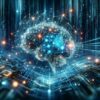Introduction to Generative AI: Definitions, Evolution, and Importance
What is Generative AI?
Generative AI refers to a category of artificial intelligence technologies that can generate new content, from text and images to music and code, based on the patterns and information it learns from large datasets. Unlike traditional AI models that are designed for analysis or prediction, generative AI actively creates new data instances that resemble the training data, yet are unique in composition.
Evolution and Technology Behind Generative AI
The journey of generative AI began with simpler models in the early days of AI research, evolving significantly with the introduction of more complex neural networks and deep learning techniques. The development of models like Generative Adversarial Networks (GANs) and Variational Autoencoders (VAEs) in the mid-2010s marked a pivotal point, enhancing the capability of AI systems to produce highly realistic and varied outputs. These advancements hinge on sophisticated algorithms that can learn from vast amounts of data, continually improving their ability to generate increasingly accurate and diverse results.
Importance and Relevance in Today’s Tech Landscape
In today’s digital era, the applications of generative AI have become increasingly vital across various sectors. This technology drives innovation in content creation, automates design processes, and even aids in solving complex scientific problems, making it a cornerstone of modern AI research and application. As businesses and creative industries seek to leverage AI for efficiency and innovation, understanding generative AI’s capabilities and mechanisms is essential. This technology not only offers significant competitive advantages but also poses new opportunities and challenges, shaping the future of how we interact with machine-generated content.
By exploring what generative AI is and how it works, stakeholders can better navigate its implications and utilize its potential to foster breakthroughs in their respective fields.
How Generative AI Works
Understanding the Underlying Algorithms
At the core of generative AI are algorithms based on neural networks and deep learning. These technologies emulate the way human brains operate, allowing machines to learn from vast amounts of data. Neural networks consist of layers of interconnected nodes or “neurons,” which process input data and generate output. Deep learning involves deeper (more layers) neural networks that enable more complex, nuanced learning and generation capabilities. By training on diverse datasets, these networks learn to recognize patterns, features, and relationships within the data.
Types of Generative Models
- Generative Adversarial Networks (GANs): GANs consist of two neural networks—generators and discriminators—competing against each other. The generator creates outputs (like images), and the discriminator evaluates them against real data, providing feedback to improve the generator’s accuracy. This adversarial process continues until the generator produces results indistinguishable from actual data.
- Variational Autoencoders (VAEs): VAEs are designed to compress data into a condensed representation and then reconstruct it back to its original form. During this process, they are able to generate new data points with variations, which makes them particularly useful for tasks like image generation where slight variations are beneficial.
- Autoregressive Models: These models predict subsequent elements in a sequence, using the previous elements as input. For text and speech generation, autoregressive models like Transformers have been particularly influential, predicting each next word or sound based on the sequence generated so far.
The Process of Training Generative AI Models
Training a generative AI model involves several key steps:
- Data Collection and Preprocessing: Gathering and preparing a large, high-quality dataset relevant to the task at hand. This may include cleaning the data and converting it into a format suitable for training.
- Model Selection and Configuration: Choosing the appropriate type of generative model and setting its parameters and architecture based on the specific needs of the project.
- Training and Tuning: The model learns to generate new data by repeatedly processing the training data, adjusting its internal parameters (weights) through techniques like backpropagation. This phase often requires significant computational power and time.
- Evaluation and Refinement: Using separate validation data to test the model’s performance and making adjustments to improve its output. The model’s ability to generate new, realistic, and varied outputs is critically assessed.
By navigating these complex processes, generative AI continues to advance, offering more sophisticated and creative solutions across various domains. This explanation provides a foundation for understanding how generative models capture and innovate based on the patterns of the world they are trained on.
Applications of Generative AI
Creative Industries: Art, Music, and Writing
Generative AI has revolutionized the creative sectors by enabling the creation of novel artworks, music compositions, and literary works. In art, AI algorithms can generate paintings and digital art pieces that mimic various historical styles or combine them to create something entirely new. In music, these models can compose pieces spanning classical to contemporary styles, often indistinguishable from compositions by human musicians. Writers and content creators use AI to draft stories, generate creative content, and even assist in scriptwriting, enabling more dynamic storytelling and content creation.
Scientific Research: Drug Discovery and Materials Science
In the realm of science, generative AI is a powerful tool for innovation, particularly in drug discovery and materials science. AI models help predict the effectiveness of new drugs by simulating their interactions with human biological systems, thereby accelerating the drug development process and reducing the need for early-stage clinical trials. In materials science, AI can predict the properties of new materials or discover combinations of materials that could lead to the development of better, more sustainable products, significantly speeding up research and development cycles.
Business and Marketing: Personalized Content and Predictive Analytics
Generative AI significantly impacts business and marketing by personalizing customer experiences and enhancing decision-making. Businesses use AI to create personalized advertising content tailored to individual preferences, thereby increasing engagement and customer satisfaction. Predictive analytics powered by AI can forecast market trends, consumer behavior, and potential sales volumes, helping companies to strategize more effectively. This application of generative AI not only improves customer interactions but also optimizes operational efficiencies and drives innovation in product and service offerings.
By leveraging generative AI across these diverse fields, industries can enhance creativity, accelerate innovation, and create more personalized experiences, illustrating the versatile and transformative power of this technology. Understanding what generative AI is and how it works is essential for tapping into its potential to revolutionize various sectors.
Ethical Considerations and Challenges
Potential Biases in AI-Generated Content
One of the primary ethical concerns with generative AI is the potential for inherent biases in the content it generates. Since these AI models learn from existing data, any biases present in the training datasets can be amplified and perpetuated in the AI’s outputs. This can lead to skewed or prejudiced content, which might reinforce stereotypes or spread misinformation. It is crucial for developers and users of generative AI to implement robust measures to identify and mitigate these biases, ensuring that the AI systems promote fairness and inclusivity.
Intellectual Property Issues and Authorship
Generative AI also raises complex questions about intellectual property rights and authorship. As AI systems generate original content, determining the ownership of these creations becomes problematic. Traditional copyright laws are not fully equipped to handle AI-generated works, creating a gray area about who—the AI, its developer, or the end user—holds the copyright. This issue necessitates new legal frameworks and guidelines to clearly define rights and responsibilities in the era of AI-driven creativity.
Privacy Concerns and the Use of Personal Data
Another significant ethical challenge is the privacy implications of generative AI technologies. These systems often require access to vast amounts of data, including personal information, to train and operate effectively. There is a risk that this data could be mishandled, inadvertently shared, or maliciously exploited, leading to privacy breaches. Ensuring data security and compliance with data protection regulations (like GDPR) is essential to maintain user trust and protect individual privacy.
Navigating these ethical considerations and challenges is vital for the sustainable and responsible development and deployment of generative AI technologies. Stakeholders must engage in ongoing dialogue and cooperation to address these issues effectively, ensuring that generative AI serves the greater good while minimizing potential harms. Understanding what generative AI is and how it operates is the first step in recognizing and tackling these ethical dilemmas.
The Future of Generative AI
Emerging Trends and Ongoing Research
The field of generative AI is rapidly evolving, with emerging trends constantly reshaping its landscape. Advances in algorithms and computational power continue to expand the capabilities and efficiency of generative models. Ongoing research focuses on creating more accurate and versatile AI systems that can generate even more complex outputs, such as hyper-realistic multimedia content and sophisticated code. Additionally, there’s a significant push towards making these technologies more accessible and easier to use, allowing a broader range of people to utilize generative AI tools without needing deep technical expertise.
Potential Impacts on Employment and Industries
As generative AI technologies become more prevalent, their impact on the workforce and various industries is profound. While AI can automate routine tasks, potentially displacing certain types of jobs, it also creates new opportunities for employment in tech-driven fields. Industries such as healthcare, entertainment, and manufacturing are undergoing transformations as AI technologies streamline operations, enhance product designs, and offer new ways to engage with customers. The challenge lies in managing this transition, ensuring that workers whose jobs are affected by AI can re-skill and adapt to new roles that the evolving job market demands.
Final Thoughts on Balancing Innovation with Ethical Responsibility
Balancing the rapid advancement of generative AI with ethical responsibility is crucial. As we harness the potential of AI to drive innovation and growth, we must also address the ethical dilemmas it poses. This involves developing regulatory frameworks and ethical guidelines that ensure the safe and fair use of AI technologies. Stakeholders from all sectors—developers, policymakers, businesses, and academia—need to collaborate to create standards that encourage innovation while protecting society from potential misuse or negative consequences of AI.
In conclusion, the future of generative AI is vibrant and full of potential, promising to revolutionize how we live and work. By fostering an environment that promotes both technological advancement and ethical governance, we can ensure that generative AI contributes positively to society and propels us towards a more innovative and equitable future.



